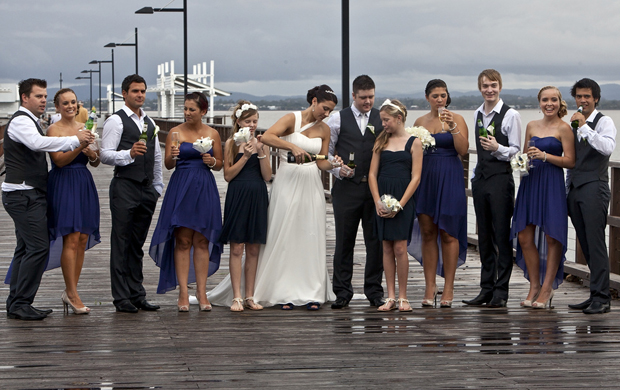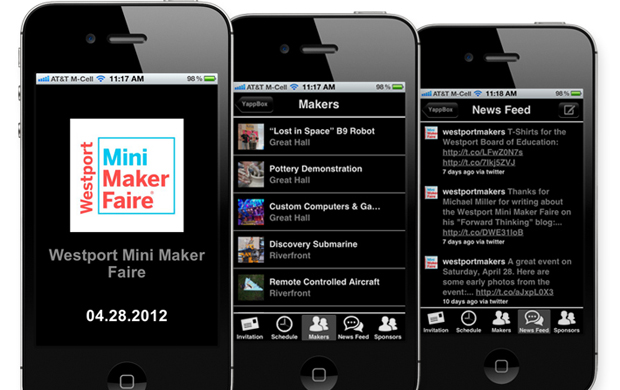Technically it's a yapp (get it, your app?), but it still might change your life. "People want to express themselves with this new medium,” cofounder Maria Seidman says. “We’re democratizing app technology." Kleiner Perkins, North Bridge, and other backers like what they see.

Last month a Mini Maker Faire was held in Westport, Conn., to celebrate creators of homemade gadgets. The debut event, inspired by Silicon Valley’s Homebrew Computer Club, had been planned three months in advance. Michael Winser, who was in charge of the show’s website and list of exhibitors and potential attendees, heard of a tool for building customizable apps. He considered making one to announce the event. What, after all, would be more fitting than a self-made app for a do-it-yourself show?
But Winser was so busy he didn't revisit the idea until a week before the event. He inputted the participants’ names and addresses into a spreadsheet, imported that to the app tool, and built the app in 15 minutes. It announced the event’s time, place, location, and had a news feed, photo gallery, and QR Code. "I literally spent more time gathering the data for the spreadsheet than I did editing the app," says Winser.
The maker of the app tool is Yapp, (a contraction of Your App), which Maria Seidman and Luke Melia launched in New York City in early April. The idea is that average shmos and non-technics should be able to make their own private app, customize it for their event, and invite only those they want to download it to their smartphones. Yapp is currently beta testing their app template, and expects to start selling it in August.
Seidman, the former head of business development and new business incubation at Warner Brothers Digital, conjured the idea after moving to New York. When it was her turn to organize a monthly meeting of her Women in New York networking group, she became frustrated with email spamming and Facebook posts, which were public because most people don’t use the privacy function. So she scoured the web for an easy way to create a good-looking mobile application. The app generators she found assumed users had content elsewhere, required basic html manipulation for designs she found ugly, or “you needed eight manuals to use them,” she says.

To create the app she wanted, Seidman enlisted Melia, former director of software development at Oxygen Media and CTO at a social site for sports called We Play. "People want to express themselves with this new medium,” Seidman says. “We’re democratizing app technology." Beta testers include a mountain climber who made one to document his climb of Mt. Everest, a private CEO summit, a conference for interns, a museum, and an engaged couple. The bride has leukemia and chemo is making it difficult for her to accompany the groom to planning events, so they used their app gallery to decide on the venue. So far, hundreds of beta testers’ invitees from 30 countries have downloaded yapps on their iPhones and Androids. Conferences, weddings, parties or social events make up roughly 60% of the yapps created. The remaining 40% is spread over assorted events.
Seidman expects yapps to appeal to women because while a small percentage work as engineers, women are disproportionately interested in social networking. Although it’s hard to estimate the market, just the 1 million-plus annual weddings in the States represent a considerable opportunity, Seidman says.
"That dwarfs the 500,000 apps in just Apple’s store today,” she notes. In addition to supporting the app development, Yapp will also help make the event itself successful. It can be consulted about the print version of an invitation that includes where to download the yapp, for example. "We’re providing an important piece of an event that someone’s planned for a long time and may be the most important day of their life," says Seidman.
"We’re providing an important piece of an event that someone’s planned for a long time and may be the most important day of their life."But the app template also appeals to the tech-savvy. Winser is a software entrepreneur. Between his startup, a time-sheet management company called Crisply, and the fair, he didn’t have the time to exercise his coding skills to build an app, he says. Besides being efficient to build, he updated the yapp within half an hour the morning of the fair, adding a new page listing sponsors. Of the 2,000 attendees, 50 downloaded the yapp from the show site.
Still, with almost a million highly specific apps available, do people really need more? Market intelligence firm International Data Corporation predicts that worldwide annual mobile app downloads will hit 182.7 billion in 2015, up from 10.7 billion just two years ago.
Seidman says that just as people pay more than $100 a month for cable TV channels, but only watch on average six or seven, the typical iOS user has 60 apps on his or her preferred device, but only consistently uses a few. So too with websites. "There are about 600 million sites today," Seidman says. "Do we need all of them?”
Seidman makes the case that in some ways apps are the new websites. “It’s almost a standard part of distribution and marketing strategies,” Seidman says. “The numbers look similar--600,000 apps, like the number of sites in the mid-'90s,” she says, citing Netcraft data. "We’re on the cusp of a third phase with early adopters starting to create apps without code or technical experience."
The economist Michael Mandel, author of the recent report “Where the Jobs Are: The App Economy,” agrees and goes back further. "This reminds me of the early days of the personal computer, when power users learned how to create little programs on their spreadsheets, called macros," Mandel says. "In fact, macros were one reason why Lotus 1-2-3 was so successful.” But he notes that the ability to write "do-it-yourself" programs on spreadsheets did not deter the creation of enormously sophisticated software packages. In the same way, we’re going to see a spate of user-customizable apps even as we see the growth of more and more sophisticated mobile applications, Mandel says.
"We are poised for the masses to be able to (create their own apps) and we need the catalyst,” says Seidman, “which we believe is tools like Yapp." So do Kleiner Perkins, North Bridge Venture Partners, Cue Ball, and individual investors, although Seidman is mum about how much capital she has raised so far.
In August the company plans to offer the basic app for free, but will charge for certain customization features, depending on the type of event, along the lines of “freemium” plans that LinkedIn, Dropbox, and Evernote offer.
Rather than make the app template available through online app stores, users will get it from a Yappbox. That’s because most yappers don’t want their app to be discovered--they’re not trying to reach mass consumers, just their contacts. And Seidman says they don’t understand or have the patience for app store submission processes.
Ultimately, yapps are not exactly apps, says Seidman, because they are based on a template, can be updated in real time, and are user-created and user content-driven. "We’re trying to bring the power of mobile technology to everyday consumers around very specific uses that enhance their lives."
[Image: Flickr user Sheba_Also]
Follow Karen A. Frenkel on Twitter, and Fast Company, too.